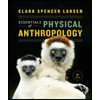ANT 203 Lab 7
.pdf
keyboard_arrow_up
School
University of Toronto, Mississauga *
*We aren’t endorsed by this school
Course
203
Subject
Anthropology
Date
Apr 3, 2024
Type
Pages
10
Uploaded by ColonelMusicHippopotamus37
First and last name: _____________________ ANT 203: Biological Anthropology Laboratory Exercise 7 Skeletal Anatomy /35 marks total, worth 5% This laboratory exercise is in three parts. You need to print this laboratory exercise document, bring it to your scheduled lab section, and complete the exercises and questions using the space provided during your lab period, then hand in the completed worksheet to your TA at the end of your lab period. All labs are due and should be submitted in hard copy at the end of the scheduled lab session. Late lab assignments will not be accepted, with no exceptions. Of the 12 scheduled labs, 8 lab assignments will be graded. Students will not know which labs will be graded until the end of each lab session. Purpose:
The fossil record often consists predominantly of broken bones and lots of teeth. On lucky occasions paleontologists find skulls or skull parts. Skull and tooth morphology has been an important source of evidence against which the hypotheses of evolutionary relationships of vertebrates may be tested. Teeth in particular fossilize well because they are extremely hard and dense; they provide information both about evolutionary relationships and about dietary habits, particularly for the mammals. In future labs we will examine hominin fossil remains, and thus it is important to first become familiar with human skeletal anatomy so that we can properly identify cranial and postcranial remains. The purpose of Parts 1-3 of this lab is to familiarize you with the human skeleton, and to understand skeletal anatomy that is unique to hominins. In Part 1 we’ll learn some basic anatomical terms
, then we will focus on cranial
(skull) anatomy in Part 2, and in Part 3 we will focus on postcranial (from the neck down) anatomy. Station 1: Basic skeletal terms, /8 marks
Review these anatomical terms while referring to the skeleton and human photographs below and answering the questions on the next page. axial skeleton
: the skull, backbone, and ribcage appendicular skeleton
: skeletal elements dealing with limbs: arms, legs, shoulder blades (scapula), and pelvis articulate/articulation
/
joint
; the place where two bones are joined prognathism
: the amount to which the face of an animal “sticks out”
proximal
: the end of the bone which articulates close to the body; closest to the trunk of body distal
: the end of the bone which is away from the body; farthest from trunk of body medial
: toward the midline of the body lateral
: away from the midline of the body anterior
: toward the front posterior
: toward the back ventral
: the stomach side of the body dorsal
: the back side of the body superior
: toward the top of the body inferior
: toward the bottom of the body
Name ___________________, ANT 203, Lab 7, page 2 1.
Is the thigh proximal or distal to the ankle? /1 mark
2.
Is the spine medial or lateral to the shoulder blade? /1 mark
3.
The wrist is __________________ to the shoulder. /1 mark 4.
The abdomen is __________________to the back. /1 mark 5.
The eyes are __________________to the nose. /1 mark
6.
The knee cap is __________________to the thigh. /1 mark
Name ___________________, ANT 203, Lab 7, page 3 7.
The clavicle is __________________and __________________to the sternum (i.e., breast bone). /2 marks Station 2: Cranial Anatomy, /15 marks
The skull consists of the neurocranium
(which contains the brain), the face
, and the mandible
(jaw). Practice locating the following bones with reference to both the cranium specimens and the photographs provided of the human skull, then refer to both the human and chimpanzee skulls to answer the questions below. /12 marks
mandible
–
the lower jaw nasals
–
make up the roof (top) of the nose maxilla
–
the bones holding the upper frontals
–
forehead area; just above the orbits dentition (teeth) zygomatics
–
cheek bones parietals
–
behind the frontals, on top (large) temporals
–
side of skull - has the ear occipital
–
back & bottom of the skull opening
Name ___________________, ANT 203, Lab 7, page 4 Additionally, locate these features on the skull. 1)
foramen magnum
–
opening through which the spinal cord meets the brain, located inferiorly. 2)
occipital condyle
–
points where the neck vertebrae articulate with the skull (on either side of the foramen magnum). 3)
orbit
–
the eye socket 4)
zygomatic arch
–
a bony arch between the orbit and the ear region. Dentition: As mammals, humans have heterodont dentition (different types of teeth), which includes incisors, canines, premolars, and molars
. When we look at one side of a dental arcade
(a row of teeth), we can count the number of these types of teeth to get a dental formula. An example of a dental formula is 3-1-4-3 for primitive mammals.
Specimen 1: Human Specimen 2: Chimpanzee Proganthism refers to how far the jaw protrudes forward. More prognathic or less prognathic? Larger or smaller canines? Larger or smaller brain? Larger or smaller crests on braincase? What is the dental formula? Shape of dental arcade in the mandible: longer and narrower or more u-shaped jaw? 8.
In which bone do you find the foramen magnum? /1 mark
Your preview ends here
Eager to read complete document? Join bartleby learn and gain access to the full version
- Access to all documents
- Unlimited textbook solutions
- 24/7 expert homework help
Recommended textbooks for you

Essentials of Physical Anthropology (Third Editio...
Anthropology
ISBN:9780393938661
Author:Clark Spencer Larsen
Publisher:W. W. Norton & Company
Recommended textbooks for you
 Essentials of Physical Anthropology (Third Editio...AnthropologyISBN:9780393938661Author:Clark Spencer LarsenPublisher:W. W. Norton & Company
Essentials of Physical Anthropology (Third Editio...AnthropologyISBN:9780393938661Author:Clark Spencer LarsenPublisher:W. W. Norton & Company

Essentials of Physical Anthropology (Third Editio...
Anthropology
ISBN:9780393938661
Author:Clark Spencer Larsen
Publisher:W. W. Norton & Company